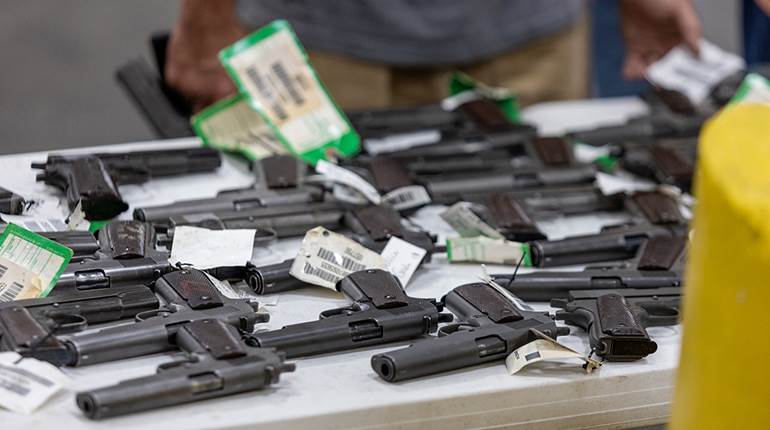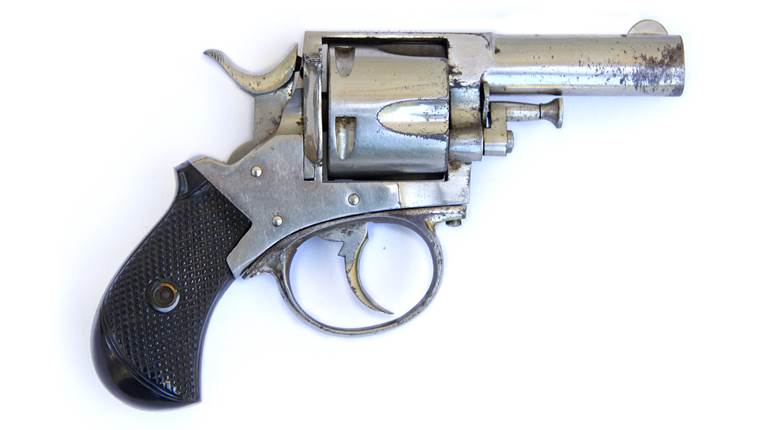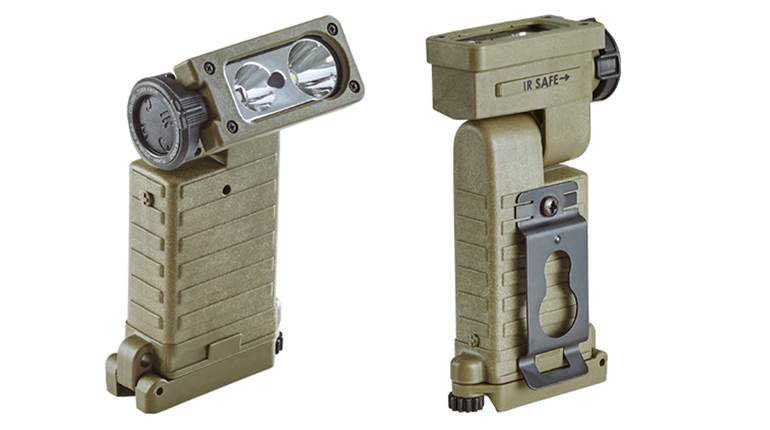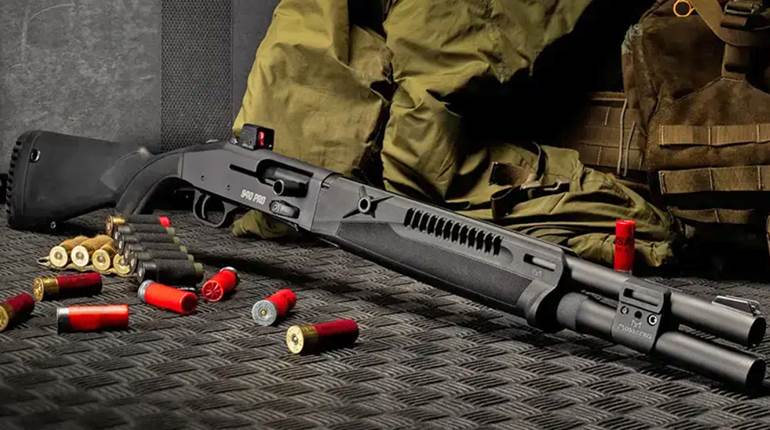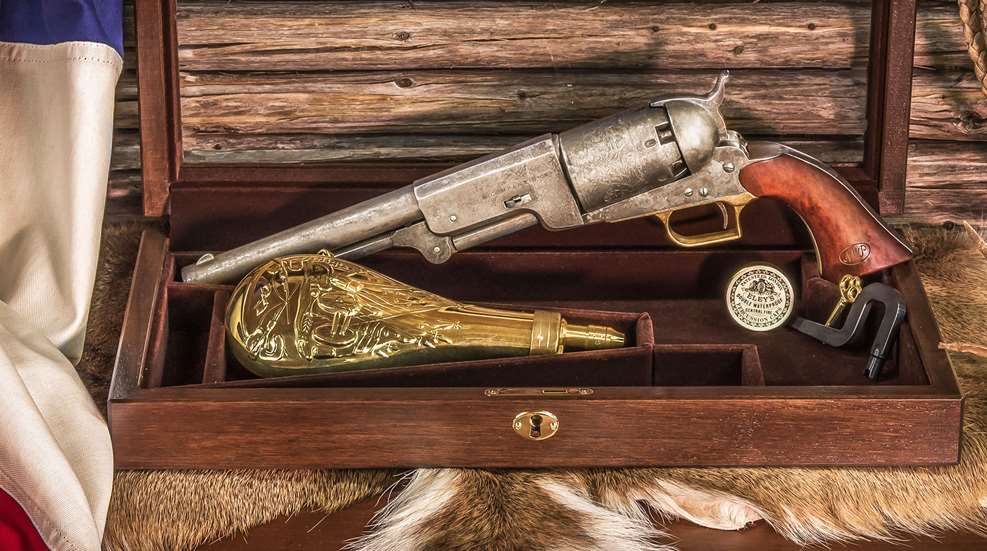
One of the more interesting facets of gun collecting is the various sub-categories it offers the enthusiast. For example, there are those who only collect World War I issues of the Colt Government M1911, or pre-’64 Winchester Model 1894s. But one of the most vibrant and enthusiastic of these sub-categories is that of collecting “Texas guns.” That is, guns that were either shipped to, used in or somehow have a link to the Lone Star State. It is a genre that is as vast as the State of Texas itself, as it appeals to and encompasses a broad spectrum of firearms enthusiasts, regardless of a Texas gun’s make, model or sometimes even condition.
As an example, all things being equal, a Colt Super .38 (an already highly-desirable handgun for shooters as well as collectors) will attract even more attention (and often with a slight bump in price) on a gun show table or at an auction if it has been originally shipped to Texas, rather than if it had been shipped to Iowa or New Jersey, for example. After all, the Super .38 has a subliminal identification with the American southwest – especially Arizona and Texas – as it is a M1911A1 chambered for a non-military caliber – the .38 Super – and therefore was not prohibited from being exported to Mexico.
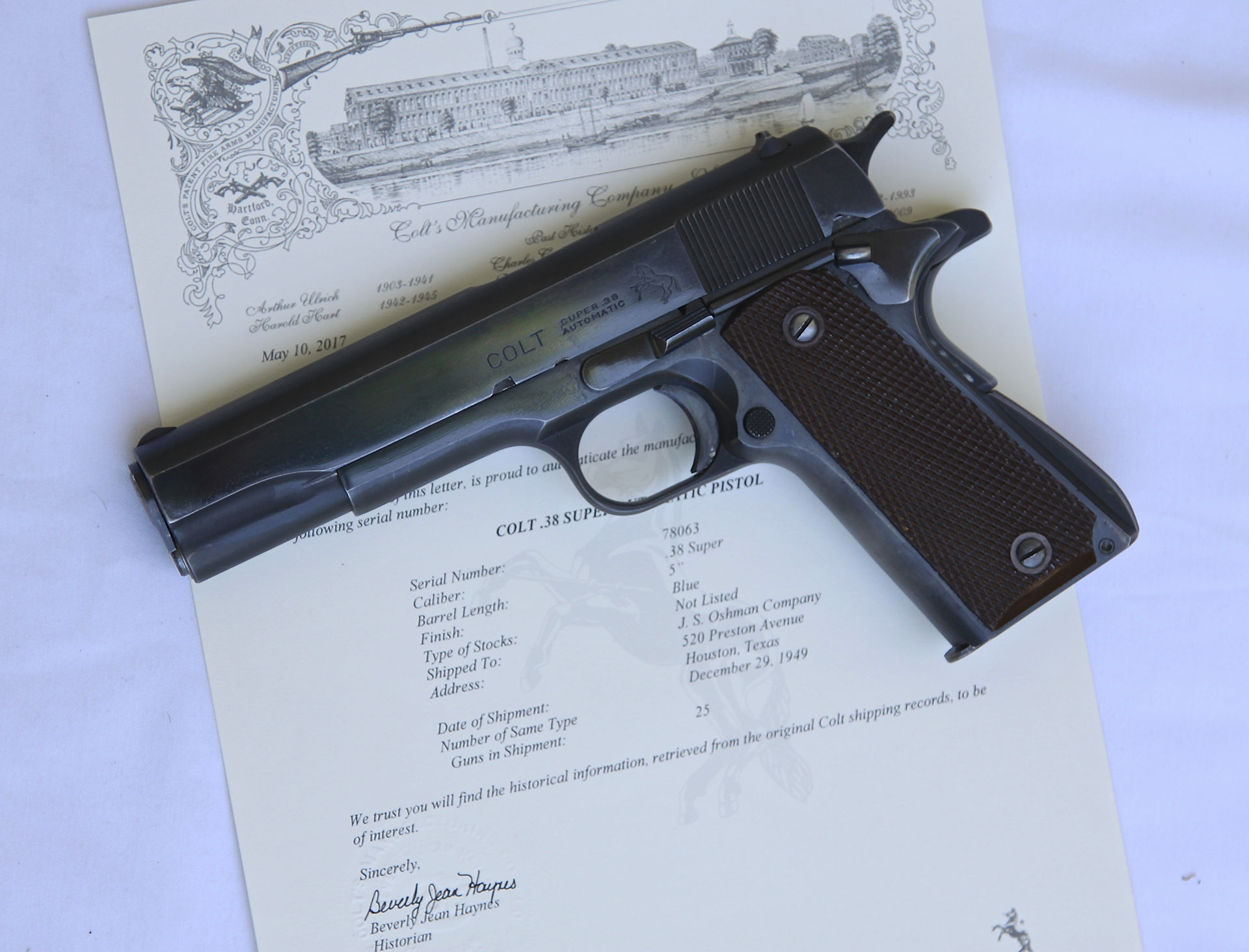
Whether or not the gun ever crossed the border is irrelevant. It has the caché. Same with even a Smith & Wesson Model 10, as another example. As ubiquitous as these guns are, if it can be verified by factory letter or some other bonafide means that it was originally shipped to Texas, it has an added aura of the Lone Star State, with its images of cattle ranches, wide open spaces, and rugged individualism. It doesn’t matter if that particular Model 10 sat in someone’s nightstand drawer all its life – if it’s a Texas gun, it automatically attracts a bit of Old West interest for certain collectors.
Of course, the very first Texas guns were the highly collectable 1836 Colt Texas Paterson and the 1847 Texas Walker – both of which have had the name “Texas” unofficially added to their nomenclatures by collectors due to their historic involvement in the early history of the Republic of Texas. On Aug. 12, 1840, 15 of the newly-formed Texas Rangers, armed with Sam Colt’s new Paterson No. 5 revolver, were able to soundly defeat a marauding band of Comanche warriors at the Battle of Plum Creek.
Then, in 1846, Texas Ranger Captain Sam Walker paid a visit to his friend Samuel Colt to ask him to help arm his limited army during Texas' war with Mexico. The result was the production of the massive 4.5 lbs. 1847 Colt Walker, which gave Col. Colt a fresh start in arms making and helped save the Republic. No wonder on May 24, 2021, Texas Governor Greg Abbott signed a resolution making the Colt Walker the official handgun of Texas. Today, both the Paterson variations and the Walker – with approximately 1,000 of each known to have been made and even fewer known to have survived - are highly collectable and carry price tags that can easily soar into the five and six digit range.
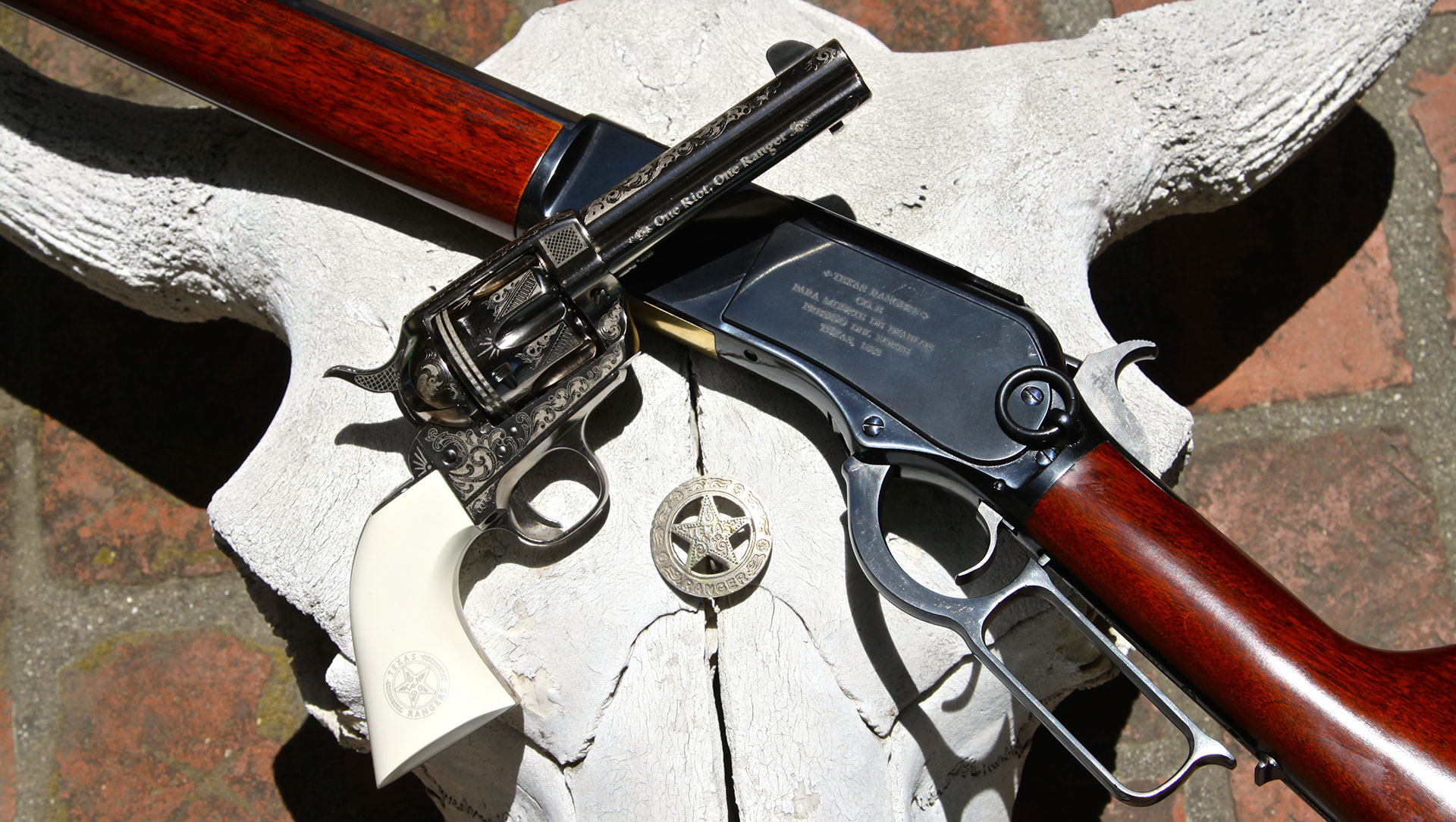
However, today, any gun – no matter how modern - that can be associated with the Texas Rangers (which celebrates its 200th anniversary in 2023) is a highly desirable collectable and almost always comes with a built-in boost in price, condition, of course, being a mitigating factor. Even though the Texas Rangers (officially known as the Texas Department of Public Safety) has adopted the SIG Sauer P320 as its current official service sidearm (and yes, in 2020 SIG Sauer announced a Texas Ranger Limited Edition P320 pistol, with a portion of the sales benefiting the nonprofit Former Texas Rangers Foundation), it is the older firearms used by the Texas Rangers that hold the most interest for gun collectors in general and Texas gun collectors specifically.
Although the Colt Single Action Army justifiably comes to mind as a sidearm that was packed by the early Texas Rangers, there are comparatively few authenticated Texas Ranger Colts that come up for sale. Merely saying, “It was once owned by a Texas Ranger” doesn’t justify a premium price. However, one such verified example came up in 2007, when Morphy Auctions catalogued a .41 Long Colt SAA with a 4.75" barrel and “Co.D” stamped on the backstrap butt. Interestingly, the gun is lettered as having been shipped to the Belknap Hardware Co., Louisville, Ky., “C/O South Texas Company D” on Sept. 5, 1906, in a one-gun shipment. At auction, this gun sold for $9,775, which included a 20-percent buyer’s premium.
An even earlier Colt single action with verified Texas Ranger credentials is a .44-cal. rimfire 1871-72 Open Top, serial number 1817 that was shipped on March 12, 1873 to Spies, Kissam & Company in New York, one of Colt’s many distributors. The gun subsequently made its way to Texas, where it was purchased by John Frank Greene, who carried it while serving as a sergeant in the Texas Rangers Minute Men Troop V in Medina County. Unfortunately, Green was shot and killed by one of his men, who was angered at having been reprimanded by Green.
However, Green’s gun, along with his Slim Jim holster, stayed in the family until recently. The gun, with letters of provenance and a book chronicling Green’s career and death was subsequently consigned to Morphy’s for their May 18, 2022 auction by Shirley Ann (Green) Sweet, the Texas Ranger’s great-granddaughter. Morphy’s pre-auction estimate was $50,000 to $75,000 and although the auction had not yet closed at the time of this writing, by April 30th the bidding was already up to $26,000. Thus, sometimes even an otherwise standard (albeit collectable in its own right, such as the Colt Open Top) gun can turn up some pleasant Texas surprises with a little research.
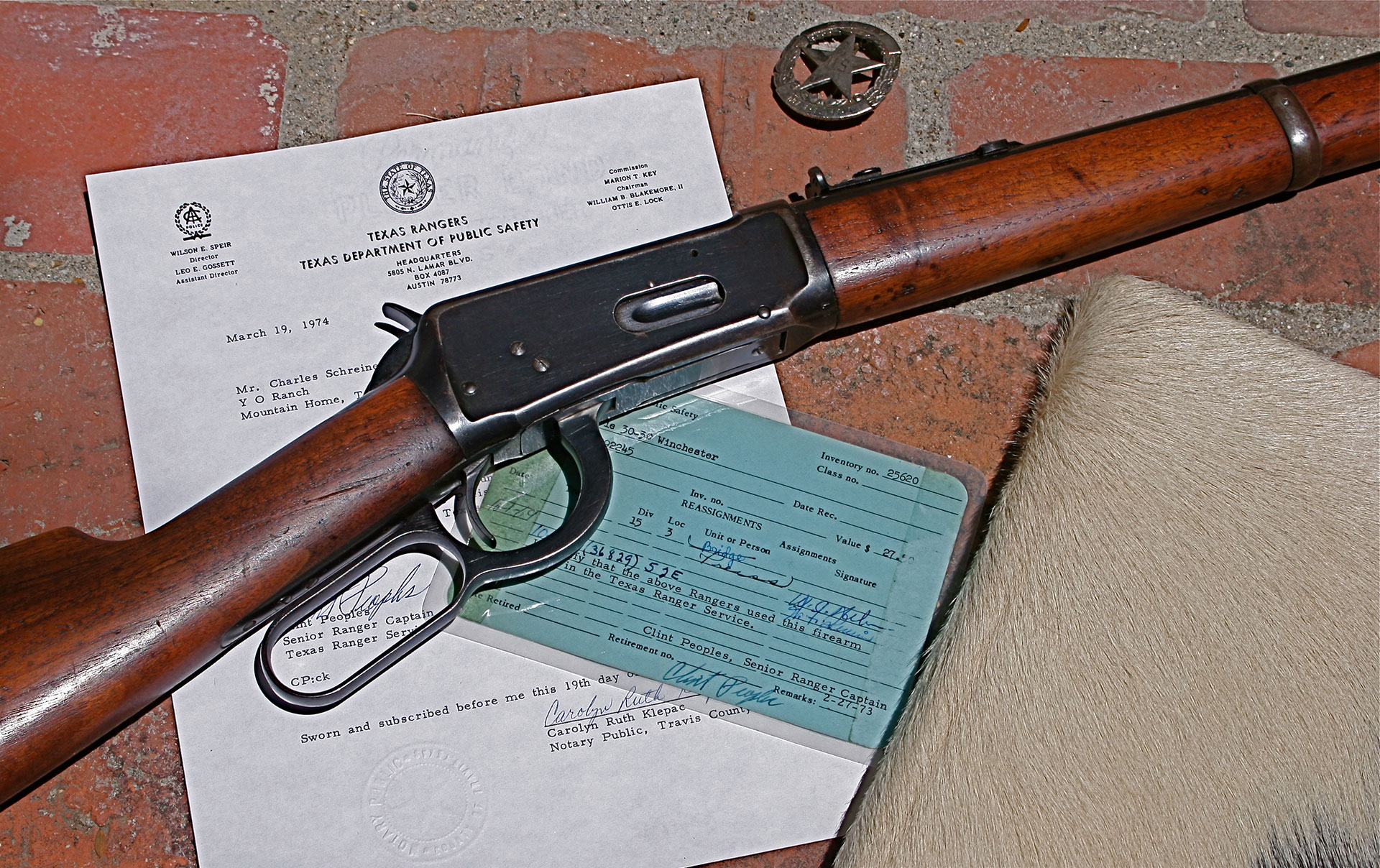
As another example, it is known that the Rangers were issued standard Winchester Model 1894 saddle ring carbines, Marlin 36 and 336 carbines (all in .30-30 Win.), as well as Winchester Model 1895 carbines. In addition, an additional number of Winchester 1894 carbines were issued to the Rangers in the 1940s. Very few of these were stamped as Texas Ranger issues, so they all, of course, must have some form of authentication to be verifiable Texas Ranger guns.
Fortunately for a select group of collectors, many of these Winchesters and Marlins were auctioned off on April 28, 2003 by Little John’s Auction Service in Santa Ana, Calif. They all came from the late Charles “Charlie Three” Schreiner III’s Y.O. Ranch collection, and due to his family’s ties with the early Texas Rangers (his grandfather had been a Texas Ranger from 1854 to 1857) they all came with notarized letters of provenance, which, of course, saved the buyers hours, weeks or even years of trying to authenticate the guns.
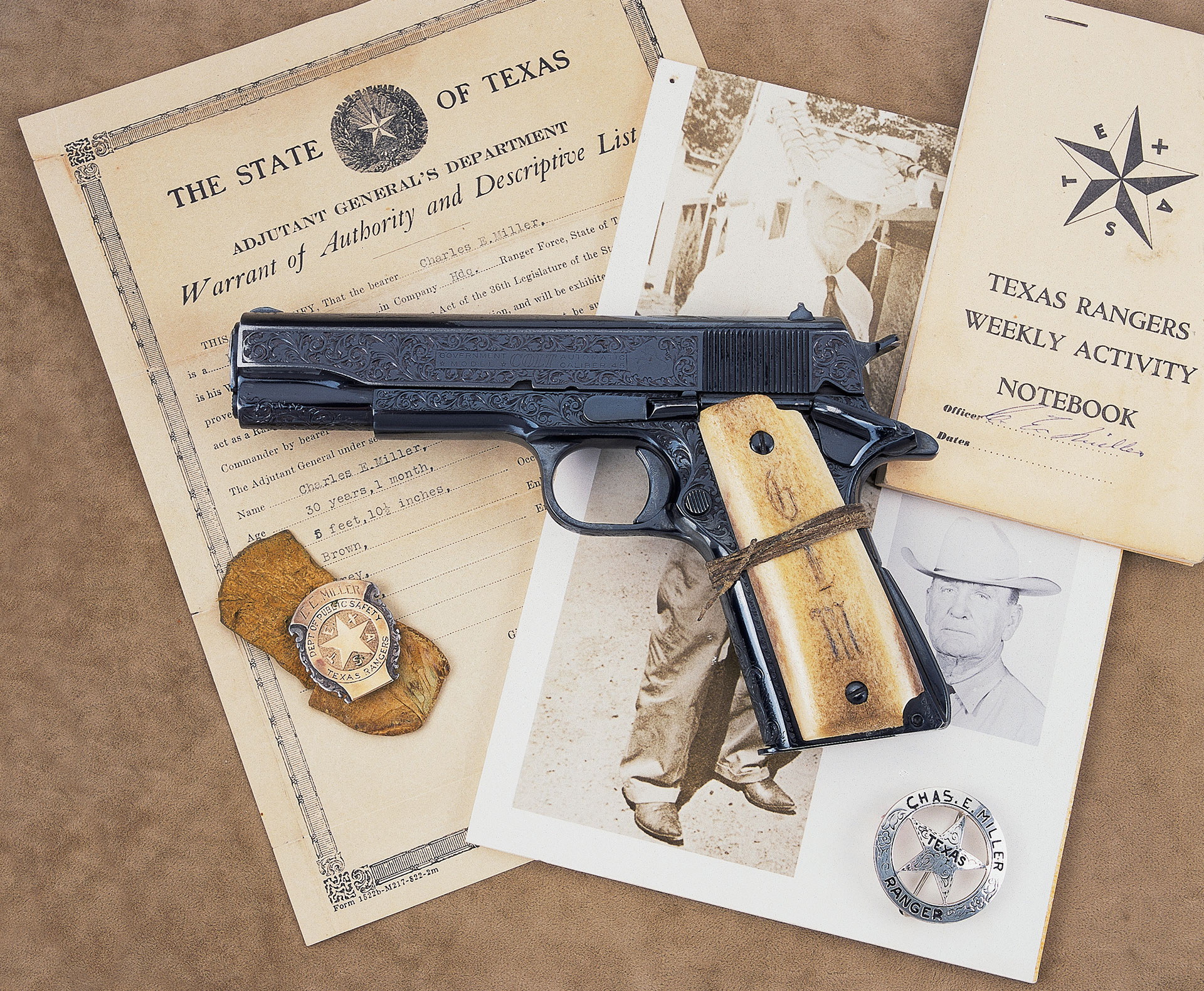
During the 20th Century, many Texas Rangers also carried the Colt Government M1911, M1911A1 and a smaller number of Colt Super .38s. Many of these guns – unlike the lever actions – were customized by their owners, who favored fancy engravings, special grips and other after-market embellishments, turning their privately purchased duty arms into very personal “barbeque guns.” Interestingly, some of these guns – which also came from Schreiner III’s Y.O. Ranch collection – were included in the same April 28, 2003 auction as the Texas Ranger carbines. Even though very few of the Rangers’ handguns were “stock,” they all brought higher-than-normal prices, which probably would not have been the case if they simply had after-market embellishments without authenticated Texas Ranger ownership.
Obviously not all Texas guns are Texas Ranger firearms. A classic example of another Texas gun collecting sub-cult are the cattle brand Colts by the late Texas engraver, Cecil Coe “Cole” Agee (1901-1955) and his fellow-Texan protégé, Weldon Bledsoe. Agee originated the cattle brand motif of engraving during the 1930s, in which a gun is given full coverage with a multitude of cattle brands, usually with punch dot backgrounds. Because of their western cattle brand theme, Agee’s work was mostly on first generation Colt Single Action Armies (second and third generation SAAs didn’t exist during Agee’s time), although a few double actions and M1911s are reported to exist (Agee rarely signed his work). The guns were often gold, nickel or silver plated, sometimes given carved steerhorn ivory grips, and the engraver was not above swapping out barrels and cylinders to convert calibers.
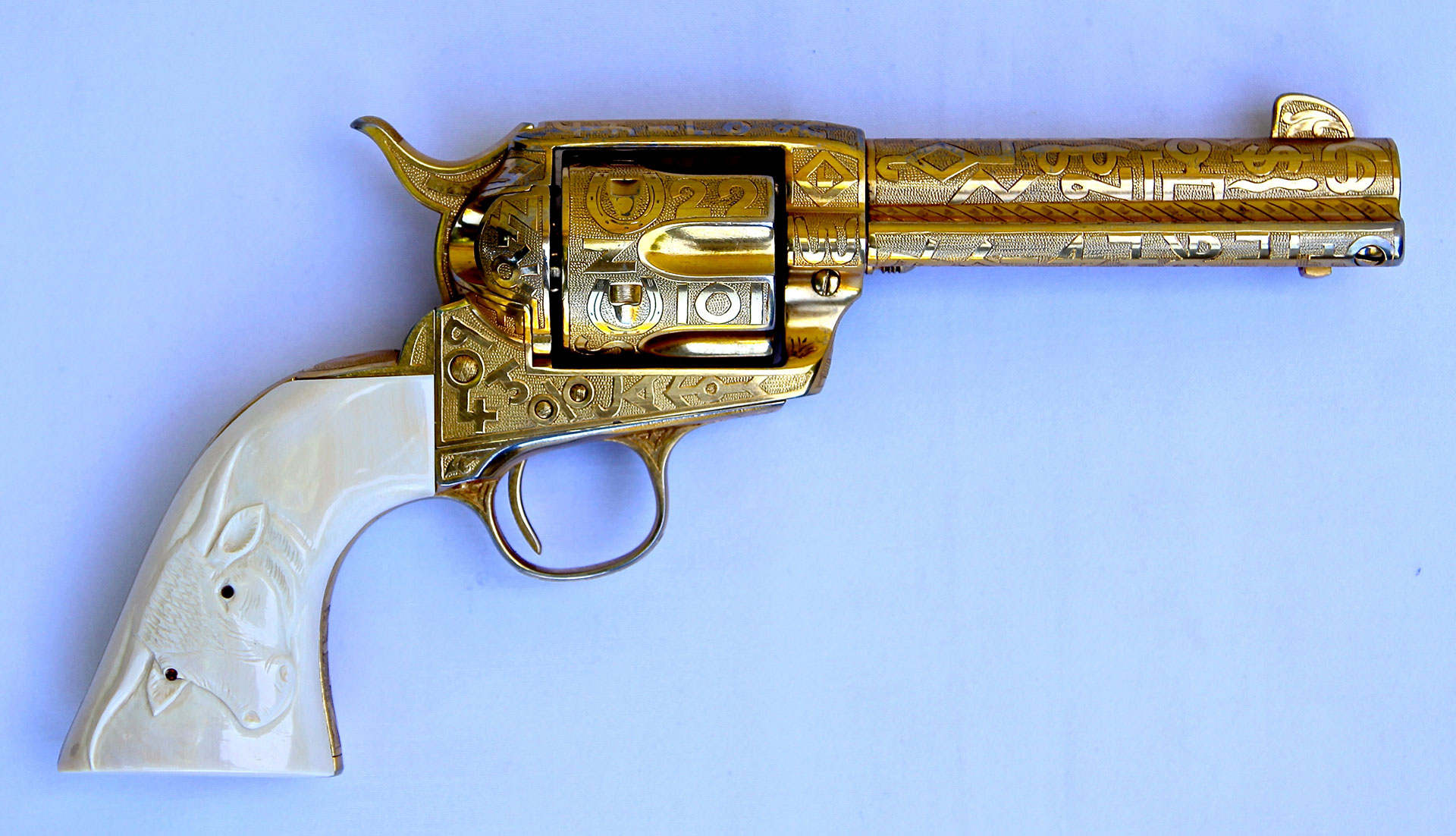
It is not known how many cattle brand Colts Agee engraved (estimates range from as little as 15 to as many as 50), but around 1950 Agee began teaching his cattle brand technique to Bledsoe, who continued the cattle brand patterns after Agee’s death, creating approximately 300 to 400 first, second and third generation cattle brand Colt single actions well into the 1980s. Although both men also engraved guns with the more commonly seen scrollwork patterns, Agee’s unique West Texas cattle brand designs were extremely popular with lawmen, western movie stars and collectors. Due to their scarcity, they are highly desirable today.
Another Texas gun collecting sub-culture are those firearms that were shipped to Wolf & Klar, a prominent Fort Worth hardware, jewelry and gun store during the late 19th and early 20th centuries. Located at 1505 Main Street, near the stockyards, Wolf & Klar was a favorite destination for cattlemen, lawmen, and other citizens of this bustling former cowtown. Wolf & Klar was also one of Colt and Smith & Wesson’s biggest customers, and often embellished factory guns with aftermarket plating, engraving and carved pearl grips, sometimes using local craftsmen with questionable abilities.
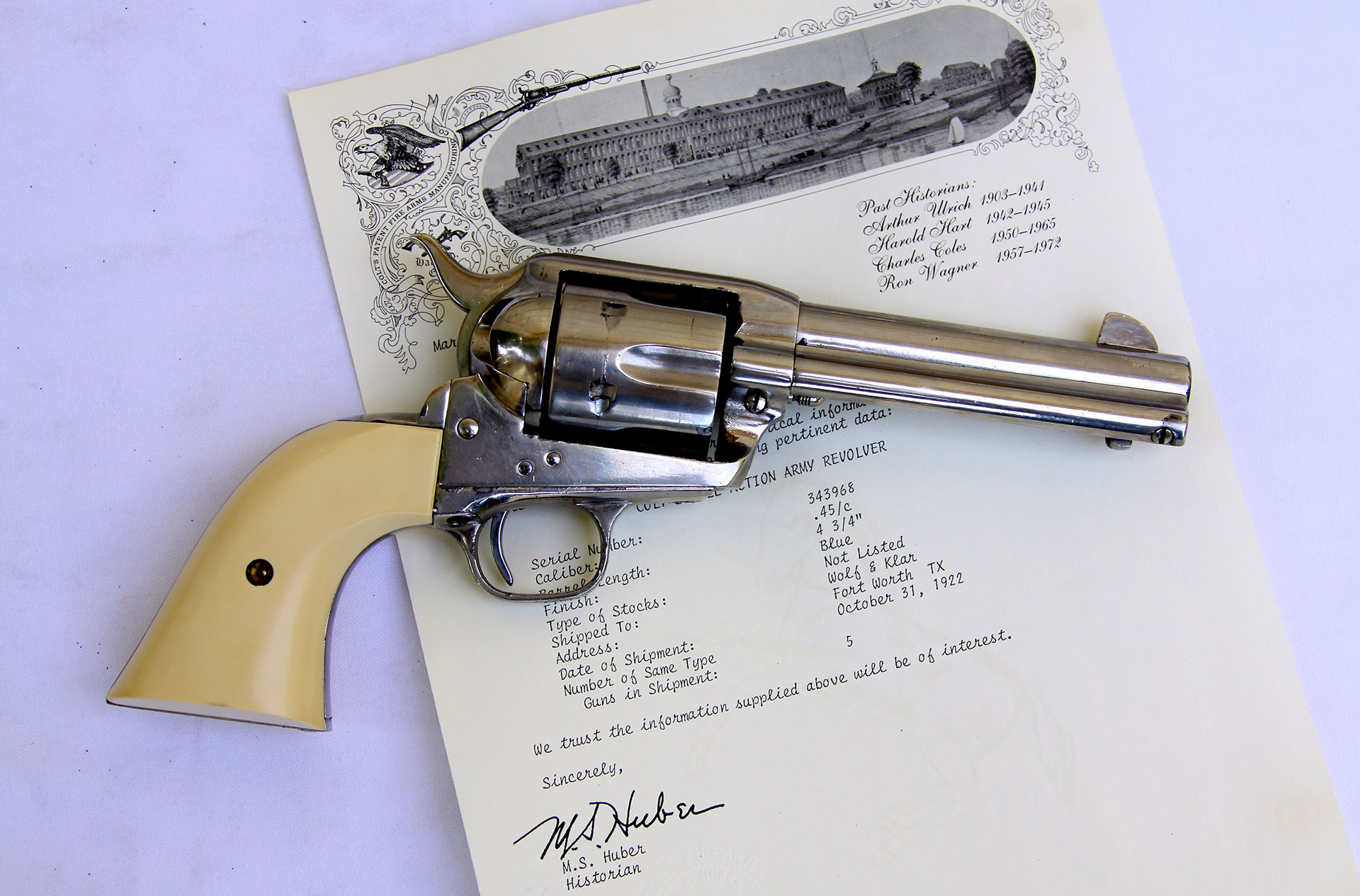
However, Colt is known for having shipped some of their Single Action Armies “in the white” to artisans like R.J. Kornbrath, who engraved them and then sent them on to Wolf & Klar, who catalogued them for sale as “Arms De Luxe.” Wolf & Klar also had the distinction of receiving the first of only 32 pre-war factory engraved Super .38s – S/N: 25 - on March 1, 1929, the first year of production. Fittingly, the gun was shipped with Mexican eagle-carved ivory stocks.
In addition, due to a large volume order, Wolf & Klar was responsible for convincing Smith & Wesson to produce the 1926 Hand Ejector Third Model, which brought back the hammer shroud under the barrel. However, of the 4,976 Third Models that were made between 1926 and 1940, when World War II halted production, only 1,000 were actually shipped to W&K. Consequently, although S&W Third Models are highly collectable themselves, those that can be verified by factory letter as having been shipped to Wolf & Klar often carry a slight premium, as, in fact, can any Texas gun with a Wolf & Klar pedigree.
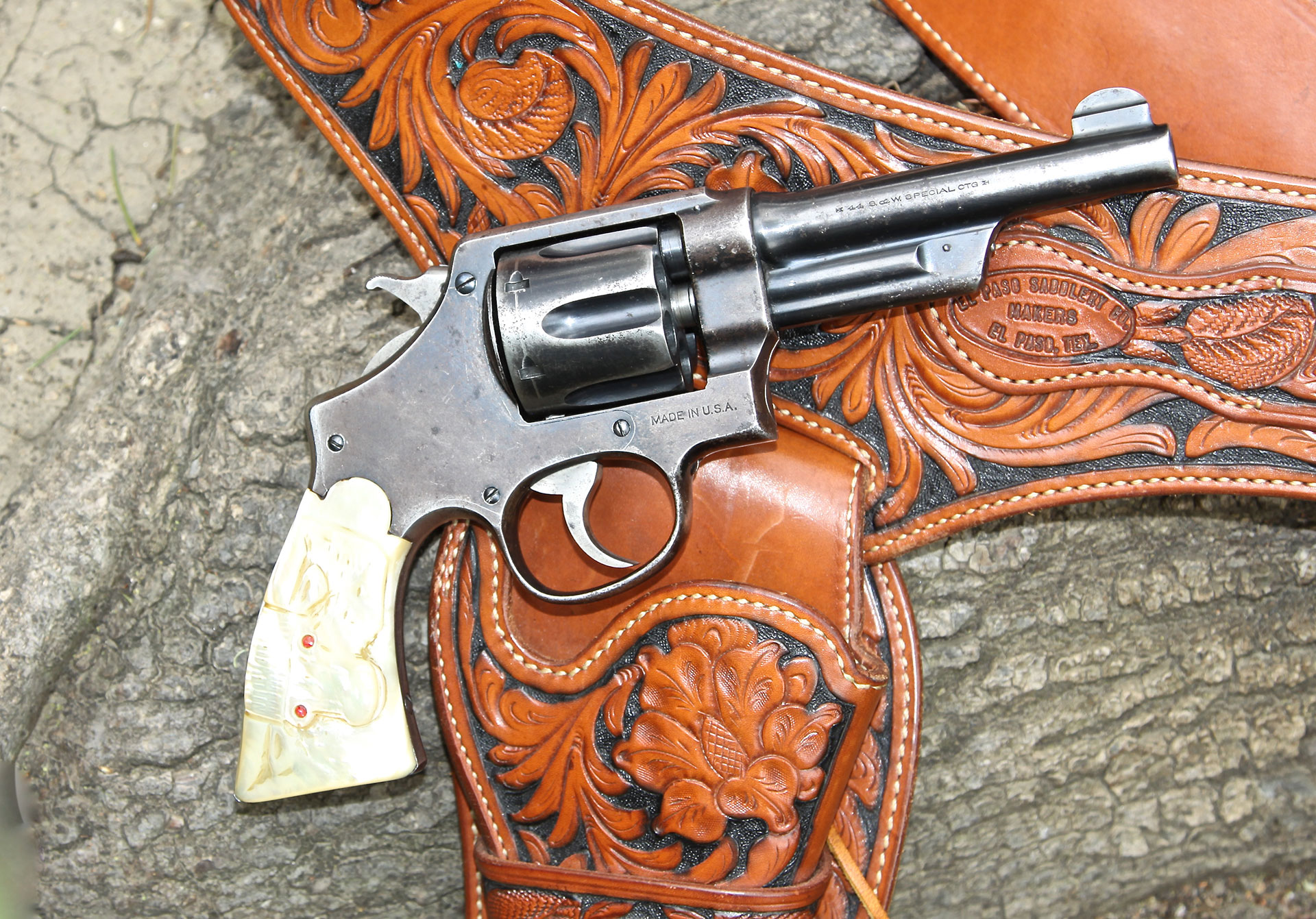
Sadly, Wolf & Klar no longer exists and its records are long gone. However, to determine if you have a Texas gun, (Wolf & Klar or otherwise) S&W factory letters can be obtained from the Smith & Wesson Historical Foundation. Colt letters may be obtained by contacting the Colt historian at coltarchives.com and Winchester letters may be obtained from the Cody Firearms Records Office – Buffalo Bill Center of the West, although Winchester letters rarely show the destination of the rifle or shotgun – only its physical configuration and date of shipment. You should also be aware that these companies charge a fee for their services. But who knows – with a little research – or a bit of luck – you may just discover that you have a Texas treasure in your gun safe.












